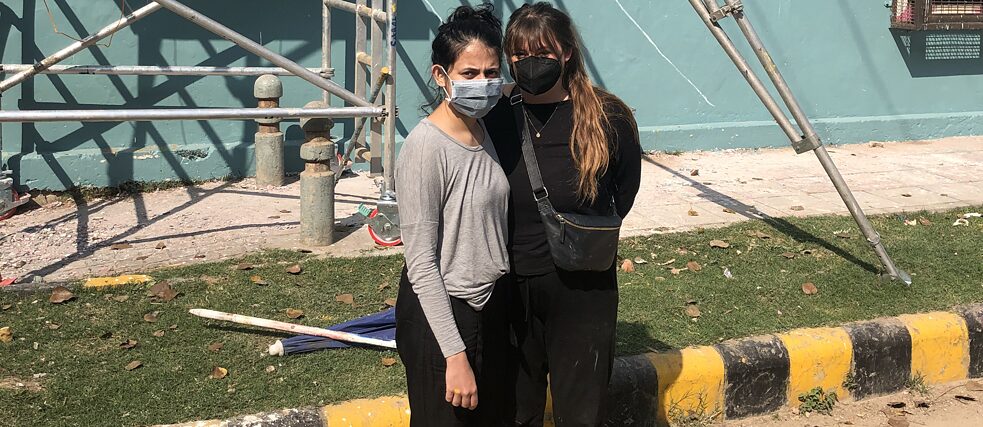In conversation
“Travelling is a state of mind, it is something the both of us share.”

Aashti Miller and Greta von Richthofen talk about the process of their collaboration and how they are searching for the meaning of travel through art.
By Faizal Khan
What is your process of collaboration and how is it shaping up?
Greta: We first started with a meeting online. Then we had this idea to emphasise on the creative focus that we share, and we started to make sketches and drawings. We sent each other notes and inspirational photos, and so it was going step by step. It was super interesting.
Aashti: I think our collaboration has been very successful. Greta said she liked working with people, I usually don't. But I don't think this experience could have been any better. I believe she is a great person to work with. Even though we are from two different countries and have completely different styles, we ended up being on the same page and it has been a lot of back and forth. Everything is posed as a suggestion and not as a critique, and it has been very productive in that way. I also think both of our skills are very different from the other´s which has helped a lot. Greta is very good at conceptualisation, sketching, and thinking through ideas. Personally, that is not a strong point of mine. I started the final drawing and that is it. So I have taken on some of that part, and she has taken on some of the early parts. Together, both designs are a perfect mixture of our styles: My, which end up being more structured and a bit more hardlined, and her´s, which is more fluid and playful.
How do you explore the meaning of travel through art?
Greta: I think travelling has so many aspects like time travelling, space travelling, and so on. I think art is about travelling, through this process step by step, growing. This is a kind of travel too.
Aashti: One of the things the both of us had discussed is how we haven't been able to travel for whatever reasons. Both of us got into drawing. Coincidentally, our drawing practices really kind of escalated during the pandemic, and they became a great escape for us. Travelling is a state of mind. It is something that both of us share. It is not just us, anyone across the world who is engaged in any creative activity can travel to a different place altogether just through the process of drawing.
What does the history and heritage of Delhi and Chennai mean to you in terms of your work?
Greta: For me, it was a bit difficult because I have never been to any of the cities before. But I did some research. We tried to find any words which had elements of the city. I researched different birds of Delhi and colours. We tried to include it.
Aashti: One of the first sketches Greta and I did, she drew some fish and I drew some other fish, and the fish were flying and doing fantastical things. From the start, we somehow agreed we have to have this fish. The reason is we started looking at Chennai first and the community who lives in the Kannagi art district had been displaced by the tsunami. So the focus was on the whole theme of displacement and how the people there were feeling like fish out of water. In addition to obviously, as Greta mentioned, having a lot of specific elements of architectural representation of Delhi, but also trees and plants and animals. It is the same for Chennai, the chrysanthemums and jackfruit, and various other things. It is also about bringing in local stories not only about ideas of not being at home, but also creating new homes, something that people can relate to when they look at it.
Could you reveal something about the initial sketches?
Aashti: Greta is very good at sketching spaces, she had put together some options for Chennai, some for Delhi. The Delhi mural is somewhat similar to the first sketch. Things have changed, but more specific elements have been incorporated. I would say our first sketch for Delhi was pretty spot on which is always great. With Chennai it was the opposite, the first sketch and the final output were different. Conceptually there are some similarities, but it doesn't look anything like the first sketch.
Greta: It was interesting to just do the sketches and go from one idea to the next.
How do you see the role of public art in a society that is reeling from the effects of the health emergency?
Greta: I think it is interesting because it is democratic, and not like you have to pay for a movie or exhibition. This art is for everybody. This is why it is interesting.
Aashti: I feel the same way about public art as I feel about the public realm in general. Now in India, we have these art festivals like the Kochi-Muziris Biennale in Kerala and Kala Ghoda Arts Festival in Mumbai. Through the years, it is sort of amazing to see a community, not that exposed to art, really take to it, really appreciate it, and come out in millions to see public art in any form.
Comments
Comment